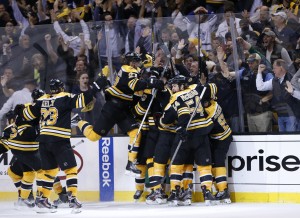By Mike Miccoli
At some point, chemistry becomes secondary. The familiarity of taking the ice with the same players turns from an advantage into more of a state of comfort and the minute that happens, things change.
Things have changed.
For the past few years, you’ve heard about the core of the Boston Bruins. You’ve heard about the advantages of their built-in chemistry, the camaraderie in the locker room, the deep lineup. You’ve heard all of it. But with the recent rash of departures from guys like Andrew Ference, Nathan Horton, Tyler Seguin, and Rich Peverley, it’s obvious that things will be different for the 2013-14 Bruins next season.

And that’s not exactly a bad thing.
If the Bruins won the Stanley Cup, there’s a strong possibility the result would have been the same. The Bruins lineup was going to be changed.
It was a given that Jaromir Jagr and (likely) Kaspers Daugavins weren’t going to be re-signed. They weren’t. Ference seemed to be the odd-man out on a blue line floundering with younger, stronger, and faster talent. He’s gone now. Horton was going to be expensive to re-sign and even if the Bruins found a way, it likely meant the end of Peverley’s tenure as a Bruin. Both will be playing elsewhere. And then there’s Seguin, a player the Bruins needed to act on fast whether it meant being patient and trusting in his future development or getting rid of him before they were handcuffed. Fireworks.
Some important pieces (though not the most important pieces) of the Boston Bruins core are gone. The one constant that Peter Chiarelli stressed all of these years was shaken up in return for upgrades. Sometimes, consistency trumps chemistry.
The Bruins’ lines will be different. The addition of Loui Eriksson (via trade) and Jarome Iginla (via free agency) instantly improves Boston’s top six forwards. Eriksson and Iginla are more ‘sure things’ offensively than both Horton and Seguin were and can stabilize the right wing of the Bruins’ depth chart. They also fit the Bruins’ style of play, making the top two lines almost completely interchangeable at any time to accommodate opponents defensive matchups.
Better yet, the two additions could actually improve the play of current Bruins. Imagine David Krejci getting to pass to shoot-first winger, Eriksson. Think about what it could be like for Iginla to finally play with a center like Patrice Bergeron or Krejci. Players like Iginla and Eriksson instantly make their linemates better and since they’re already going into a pretty good situation in Boston, the possibilities really are endless.
Another advantage of the shakeup is the fact that a Stanley Cup hangover may not be an issue. Even though the 2013 season ended without the ultimate goal of a Stanley Cup, the Bruins and the Chicago Blackhawks will still have the shortest offseasons out of any other NHL team. Aside from the notion that all players should be competing and no longer comfortable with their current play, a shakeup of the Bruins lineup ensures that the fresh legs of the new additions will rejuvenated enough to withstand the beginning of the regular season after a normal offseason. At least, that’s the hope.
The Bruins lineup won’t be what you’re used to, but that’s okay. The measurement of what was lost in chemistry within the team will be made up in consistency on the front lines. While it’s still yet to be determined what the Bruins’ third line will look like and how the defensive corps will shape up, this is one of those circumstances where breaking up a team’s chemistry and core will actually work in its favor.
Follow Mike on Twitter for more Bruins updates, news, and commentary.